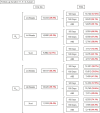E. Portaccio received compensation for travel grants, participation in advisory boards, and/or speaking activities from Biogen, Merck Serono, Sanofi, Teva, Roche, BMS Celgene, Janssen, and Novartis; and serves on the editorial board of Frontiers in Neurology and Brain Sciences. L. Pastò received research support from Novartis and Biogen; and speaker honoraria from Teva. A. Lugaresi served as an advisory board member for Biogen, Horizon, Merck, Novartis, Roche, and Sanofi/Genzyme; she received travel/accommodation expense compensations or speaker honoraria from Alexion, Biogen, Bristol Myers Squibb, Johnson & Johnson, Merck Serono, Novartis, Roche, Sanofi/Genzyme, and Fondazione Italiana Sclerosi Multipla (FISM); and her institutions received research grants from Novartis, Roche and Sanofi/Genzyme. E. Cocco received research grants and honoraria as a speaker and member of advisory boards from Almirall, Bayer, Biogen Idec, Merck Serono, Novartis, Sanofi-Genzyme, Teva, and Roche. F. Patti received honoraria for speaking activities from Almirall, Bayer Schering, Biogen Idec, Merck Serono, Novartis, Roche, Sanofi-Genzyme, and TEVA; served as advisory board member for the following companies: Alexion, Almirall, BMS Celgene, Janssen, Bayer Schering, Biogen Idec, Merck Serono, Novartis, Roche, Sanofi-Genzyme, and TEVA; was funded by Biogen, Merck, Novartis, Reload Association, Italian Health Minister, Italian University Minister University of Catania, and FISM for epidemiologic studies; and received grants for congress participation from Almirall, Bayer Schering, Biogen Idec, Merck Serono, Novartis, Roche, Sanofi-Genzyme, and TEVA. V.L.A.M. Torri Clerici received honoraria for speaking or writing from Novartis, Sanofi-Genzyme, Almirall, Bristol Myers Squibb, and Horizon; acted as an advisory board member for Biogen, Lundbeck, Novartis, Sanofi-Genzyme, Bristol Myers Squibb, Roche, Almirall, and Merck-Serono; is involved as principal investigator in clinical trials for Sanofi-Genzyme, FISM, Bristol Myers Squibb, Roche, and Merck-Serono; and has received support for research projects from Almirall. D. Ferraro has received travel grants and/or fees for speaking and/or advisory boards from Alexion, Biogen, Bristol Myers Squibb, Celgene, Merck, Novartis, Roche, and Sanofi. V. Brescia Morra received grants to attend scientific congresses or speaker honoraria from Biogen, Merck-Serono, Novartis, Roche, Sanofi/Genzyme, and Teva. G. Salemi received grants to attend scientific congresses or speaker honoraria from Biogen, Merck-Serono, Novartis, Roche, Sanofi/Genzyme, Teva, Alexion, BMS Celgene, and Horizon. M. Vianello received compensation for travel grants or speaking activities from Biogen, Merck Serono, Roche, BMS Celgene, Janssen, and Novartis. R. Cerqua has received funding for travel and/or speaker honoraria from Sanofi, Biogen Idec, Merck-Serono, and Roche. M. Inglese received grants from NIH, NMSS, FISM; and received fees for consultation from Roche, Genzyme, Merck, Biogen, and Novartis. P. Perini reports grants from Almirall, Teva, Sanofi-Genzyme, Merck Serono, Biogen Italy, Novartis, and Roche; and for consultancy for Novartis, Biogen Italy, Sanofi-Genzyme, and Roche. S. Romano reports fees as a speaker and travel expense refunds from Biogen, Novartis, and Roche. C. Pozzilli received honoraria for speaking or consultation fees from Almirall, Biogen, Merck, Novartis, Sanofi, Teva, and Roche. C. Tortorella received honoraria for speaking and travel grants from Almirall, Bayer, Biogen, Merck, Novartis, Roche, Sanofi, and Teva. A. Di Sapio received personal compensation for speaking and consulting from Biogen, Novartis, and Genzyme; and has been reimbursed by Merck, Biogen, Genzyme, and Roche for attending several conferences. P. Annovazzi received honoraria for lecturing and participation in advisory boards and/or travel expenses for attending congresses and meetings from Alexion, Almirall, Biogen, BMS-Celgene, Janssen, Merck, Novartis, Roche, Sanofi-Genzyme, Teva, and Viatris. P. Iaffaldano received grants to attend scientific congresses or speaker honoraria from Biogen, Merck-Serono, Novartis, Roche, Sanofi/Genzyme, and Teva. M.A. Rocca received consulting fees from Biogen, Bristol Myers Squibb, Eli Lilly, Janssen, and Roche; received speaker honoraria from AstraZeneca, Biogen, Bristol Myers Squibb, Bromatech, Celgene, Genzyme, Horizon Therapeutics Italy, Merck Serono SpA, Novartis, Roche, Sanofi, and Teva; receives research support from the MS Society of Canada, the Italian Ministry of Health, the Italian Ministry of University and Research, and Fondazione Italiana Sclerosi Multipla; and is an associate editor for Multiple Sclerosis and Related Disorders. M. Filippi is Editor-in-Chief of the Journal of Neurology; received compensation for consulting services and/or speaking activities from Bayer, Biogen Idec, Merck Serono, Novartis, Roche, Sanofi-Genzyme, Takeda, and Teva Pharmaceutical Industries; and still receives research support from Biogen Idec, Merck Serono, Novartis, Roche, Teva Pharmaceutical Industries, Italian Ministry of Health, Fondazione Italiana Sclerosi Multipla, and ARiSLA (Fondazione Italiana di Ricerca per la SLA). M. Trojano received travel and/or speaker honoraria from Sanofi Aventis, Genzyme, Biogen Idec, Teva, Merck, Serono, and Novartis; and reported receiving speaker honoraria and research grants to her institution from and serving on advisory boards of Biogen, Merck Serono, and Novartis. M.P. Amato served on scientific advisory boards for and has received speaker honoraria and research support from Biogen Idec, Merck Serono, Bayer Schering Pharma, and Sanofi Aventis; and serves on the editorial boards of Multiple Sclerosis Journal and BMC Neurology. All other authors report no relevant disclosures. Go to Neurology.org/N for full disclosures.


